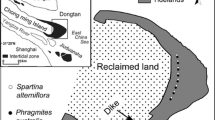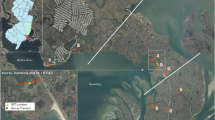Abstract
The invasion of Phragmites australis (common reed) into Spartina alterniflora (cordgrass) salt marshes along the northeastern coast of the United States has recently been of concern. Numerous studies have evaluated the effects of P. australis on marsh nekton and infauna, but its effects on the distribution of stem-dwelling epifaunal communities has not been investigated previously. Standing living and dead plants of both species were collected periodically during three growing seasons (2000–2002) from brackish and salt marshes in New Jersey and Long Island, and the abundance, composition, and diversity of epifaunal communities associated with the stems of the two plant species were compared. Spartina alterniflora, particularly dead S. alterniflora, supported a higher density of animals than P. australis in 12 of the 19 samplings. When communities on standing live and dead stem were considered separately, higher abundances were found on dead S. alterniflora stems. Nematodes and harpacticoid copepods were the dominant taxa, with mites, annelids, and insects comprising minor components. Taxon-specific abundances tended to be higher on S. alterniflora stems, and community diversity was generally greater on this species as well. Between-site and between-year variation was observed. Relative to data recorded from sub-tropical salt marshes, the epifaunal communities in our samples were less abundant and diverse. Differences in the epiphytic communities associated with the two species, along with differences in stem structure, may explain why S. alterniflora stems support more epifaunal animals than P. australis stems overall.
Similar content being viewed by others
Literature Cited
Able, K. W. and S. M. Hagan. 2000. Effects of the common reed (Phragmites australis) invasion on marsh surface macrofauna: responses of fishes and decapod crustaceans. Estuaries 23:633–646.
Angradi, T. R., S. M. Hagan and K. W. Able. 2001. Vegetation type and the intertidal macroinvertebrate fauna of a brackish marsh: Phragmites vs Spartina. Wetlands 21:75–92.
Bell, J. D. and M. Westoby. 1986. Abundance of macrofauna in dense seagrass is due to habitat preference, not predation. Oecologia 68:205–209.
Bell, S. S. and L. D. Coen. 1982. Investigations on epibenthic meiofauna II. Influence of microhabitat and macroalgae on abundance of small invertebrates on Diopatra cuprea (Bosc) (Polychaeta: Onuphiddae) tube-caps in Virginia. Journal of Experimental Marine Biology and Ecology 61:175–188.
Bell, S. S. and B. C. Coull. 1978. Field evidence that shrimp predation regulates meiofauna. Oecologia 35:141–148.
Coull, B. C. 1990. Are members of the meiofauna food for higher trophic levels? Transactions of the American Microscopical Society 109:233–246.
Coull, B. C. and J. B. Wells. 1983. Refuges from fish predation: experiments with phytal amphipods in the New Zealand rocky intertidal. Ecology 64:1599–1609.
Fell, P., S. P. Weissbach, D. A. Jones, M. A. Fallon, J. A. Zepieri, E. K. Faison, K. A. Lennon, K. J. Newberry, and L. K. Reddington. 1998. Does invasion of oligohaline tidal marshes by reed grass, Phragmites australis (Cav.) Trin. Ex Steud., affect the availability of prey sources for the mummichog, Fundulus heteroclitus L. Journal of Experimental Marine Biology and Ecology 92:171–177.
Fleeger, J. W., P. O. Yund, and B. Sun. 1995. Active and passive processes associated with initial settlement and post-settlement dispersal of suspended meiobenthic copepods. Journal Marine Research 53:609–645.
Gee, J. M. 1989. An ecological economic review of meiofauna as food for fish. Zoological Journal of the Linneaus Society 96:243–261.
Gregg, C. S. and J. W. Fleeger. 1998. Grass shrimp Palaemonetes pugio predation on sediment and stem-dwelling meiofauna: field and laboratory experiments. Marine Ecology Progress Series 175:77–86.
Healy, B. and K. Walters. 1994. Oligochaeta in Spartina stems: the microdistribution of Enchytraeidae and Tubificidae in a salt marsh, Sapelo Island, USA. Hydrobiologia 278:111–123.
Kemp, P. F. 1990. The fate of benthic bacterial production. Critical Review of Aquatic Sciences 2:109–124.
Kneib, R. T. 1982. Habitat preference, predation, and the intertidal distribution of gammaridean amphipods in a North Carolina salt marsh. Journal of Experimental Marine Biology and Ecology 59: 219–230.
Meyer, D. L., J. M. Johnson, and J. W. Gill. 2001. Comparison of nekton use of Phragmites australis and Spartina alterniflora marshes in the Chesapeake Bay, USA. Marine Ecology-Progress Series 209:71–84.
National Climatic Data Center. 2002. Climate of 2000: August, national temperatures. ONLINE. National Oceanographic and Atmospheric Administratio. Available: http://www.ncdc.noaa.gov/oa/climate/research/2002/aug/nattemp.html [13 September 2002].
Newell, S. Y. 1993. Decomposition of shoots of a salt-marsh grass: methodology and dynamics of microbial assemblages. Advances in Microbial Ecology 13:301–326.
Orth, R. J., K. L. Heck, and J. van Montfrans. 1984. Faunal communities in seagrass beds: a review of the influence of plant structure and prey characteristics on predator-prey relationships. Estuaries 7:339–350.
Osenga, G. A. and B. C. Coull. 1983. Spartina alterniflora Loisel root structure and meiofaunal abundance. Journal of Experimental Marine Biology and Ecology 67:221–225.
Quinn, J. R. 1997. Fields of Sun and Grass: an Artist’s Journal of the New Jersey Meadowlands. Rutgers University Press, New Brunswick, NJ, USA.
Rutledge, P. A. and J. W. Fleeger. 1993. Abundance and seasonality of meiofauna, including harpacticoid copepod species, associated with stems of the salt-marsh cord grass, Spartina alterniflora. Estuaries 16:760–768.
Talley, T. S. and L. A. Levin. 2001. Modification of sediments and macrofauna by an invasive marsh plant. Biological Invasions 3: 51–68.
Van Dolah, R. F. 1978. Factors regulating the distribution and population dynamics of the amphipod Gammarus palustris in an intertidal salt marsh. Ecological Monographs 48:191–217.
Walters, K., E. Jones, and L. Etherington. 1996. Experimental studies of predation on metazoans inhabiting Spartina alterniflora stems. Journal of Experimental Marine Biology and Ecology 195: 251–265.
Watzin, M. C. 1983. The effects of meiofauna on settling macrofauna: meiofauna may structure macrofaunal communities. Oecologia 59:163–166.
Weinstein, M. P. and J. H. Balletto. 1999. Does the common reed, Phragmities australis, affect essential fish habitat? Estuaries 22: 793–802.
Weis, J. S. and P. Weis. 2000. Behavioral responses and interactions of estuarine animals with an invasive marsh plant: a laboratory analysis. Biological Invasions 2:1–20.
Windham, L. and R. G. Lathrop. 1999. Effects of Phragmites australis on aboveground biomass and soil properties in a brackish tidal marsh. Estuaries 22: 927–935.
Yuhas, C. E. 2001. Benthie communities in Spartina alterniflora and Phragmites australis dominated salt marshes. Master’s Thesis. New Jersey Institute of Technology, Newark, NJ, USA.
Author information
Authors and Affiliations
Corresponding author
Rights and permissions
About this article
Cite this article
Robertson, T.L., Weis, J.S. A comparison of epifaunal communities associated with the stems of salt marsh grasses Phragmites australis and Spartina alterniflora . Wetlands 25, 1–7 (2005). https://doi.org/10.1672/0277-5212(2005)025[0001:ACOECA]2.0.CO;2
Received:
Revised:
Accepted:
Issue Date:
DOI: https://doi.org/10.1672/0277-5212(2005)025[0001:ACOECA]2.0.CO;2




